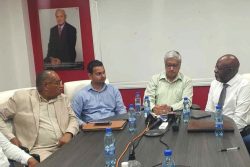Work on the surfacing of the Demerara Harbour Bridge (DHB) has not yet begun as a suitable “binder” has not yet been found.
General Manager of the DHB Corporation, Nazzurdeen Aziz, speaking with Stabroek News last Thursday said that the search for a suitable material for the surfacing of the bridge was still on as previous materials tested were not successful.
A Government Informa-tion Agency (GINA) press release last December had stated that work on surfacing the bridge was to have commenced the week before Christmas. The release had said that the decking would be resurfaced using RC 250 bitumen with aggregate which was previously used and was successful when a section of the bridge was resurfaced as a test model before the actual commencement of work.
Quizzed on this, Aziz revealed that the test “wasn’t too successful” and so a suitable material was still to be found. He said another test was carried out on March 8 but they would have to wait and see how it works out. He said surfacing the bridge was different from surfacing the road and the “idea of a test coat is to try to come up with a suitable binder and or suitable material”.
When Stabroek News observed the area which had been surfaced it was noticed that numerous cracks had already appeared in the asphalt. Aziz said they were “trying various materials” but cautioned that it was too early to say how it was working out. He said that once a suitable material was found “within a week the bridge will be resurfaced.”
According to the GINA release in December, the work is expected to be completed within four months working mostly during the off-peak travelling period and with one lane being open at all times. The management of the DHB will assist in supervising the work to ensure that the traffic flows smoothly.
GINA had said that the contract was awarded last August to Golden Star Construction Company but was delayed because several deck plates had to be replaced. It had noted too that the improvement works will give more longevity to the bridge and make it safer for traffic, particularly during wet conditions.
The two-lane bridge constructed in the 1970s is a vital link between Region Four on one side and Regions Three and Two and beyond on the other.
It was designed by Thomas Storey Engineers Limited using Acrow Panel Bridge and Uniflote. The contract was signed on May 24, 1976. The bridge was managed by a semi-autonomous body and it became a corporation on April 14, 2003.





